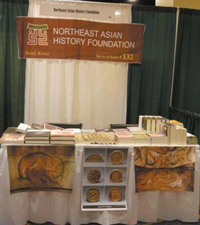NORTHEAST ASIAN HISTORY FOUNDATION 05/2010
-
Yun Ji-seon Administrative Officer, Office of Public Relations
 The Foundation's titles displayed
The Foundation's titles displayedat AAS book exhibition
The 2010 Annual Conference of the Association for Asian Studies (AAS) was held from March 25 to 28 in Philadelphia, PA, USA. Along with the conference was a book exhibition of publications related to Asian history. Reservations for the 132 booths were completed way before the conference, demonstrating the Americans' great interest in Asian studies.
Many world-renowned universities press—e.g. Harvard University Press, Yale University Press, and Cambridge University Press—participated. Of note was the avid interest in China and the unwavering strength of Japan-related publications. It was also evident that interest in Korea is beginning to grow. Northeast Asian History Foundation's publications were well received. Most publishers in the United States specialize in Japan or China-related publications. Also, there were many Chinese and Japanese publishers at the exhibition. Therefore, the Foundation was more or less the sole representative of Korea-related works.
Before the book exhibition, we were worried that we did not have enough English-language titles. However, once we got there, we realized what truly mattered was content and topic, not language. An urgent task at hand is finding topics that pique the interest of Western scholars of Asian history. From what we have gathered, there is a great interest in old newspaper articles, advertisements, and other everyday materials that can serve as historical sources.
The book exhibition was significant in that we were able to introduce the Foundation's research findings to not only scholars in the English-speaking world but also to scholars of Asian history in East Asia. We realized the need for our continued participation in the exhibition and for a more active approach to distributing the Foundation's research findings. The following section outlines the areas in which the Foundation must make improvements.
Content and theme over language
First, we must expand our exhibition catalogue. This time around, we displayed a few select titles we felt Western scholars would find interesting. However, it would be more effective to respond to the demands and needs we encounter at the exhibition through order forms and a comprehensive catalogue of all our titles.
Second, we need to cooperate with other publishers that produce works related to Korean studies. For example, at the exhibition was a Japanese publisher that specializes in Japanese language learning materials. People who are interested in Korean studies must first learn Korean; they need access to relevant materials and programs. We could work with a company or an organization that produces Korean language learning materials and runs Korean language programs.
Third, we must provide greater diversity and specificity in terms of the subject matters treated by our publications. This way, we would be able to propose a wider range of research topics to scholars and provide them with more effective assistance in their studies.
Finally, on the last day of the exhibition, we gave out all sample titles we had free of charge. People liked the books, and some North American librarians expressed their gratitude to the Foundation for our continued donation of our publications. However, the response was not all positive. It is not customary in the United States for publishers or organizations to give out their titles free of charge. Therefore, the free handout of our titles ended up depreciating their value and scholarly merit. If we provide information about our titles and get people to buy them, it will raise the value of our books and we will be able to get the books to those who really need them.
The exhibition once again reminded us that Korean history should not merely be studied in Korea. We must be more active and committed to disseminating it overseas, especially to the English-speaking world. Moreover, we must work hard to meet the growing interest in Korea history outside Korea. Finally, the Foundation must produce high-quality publications and does its part in letting the world know about Korea's cultural superiority and research findings.


